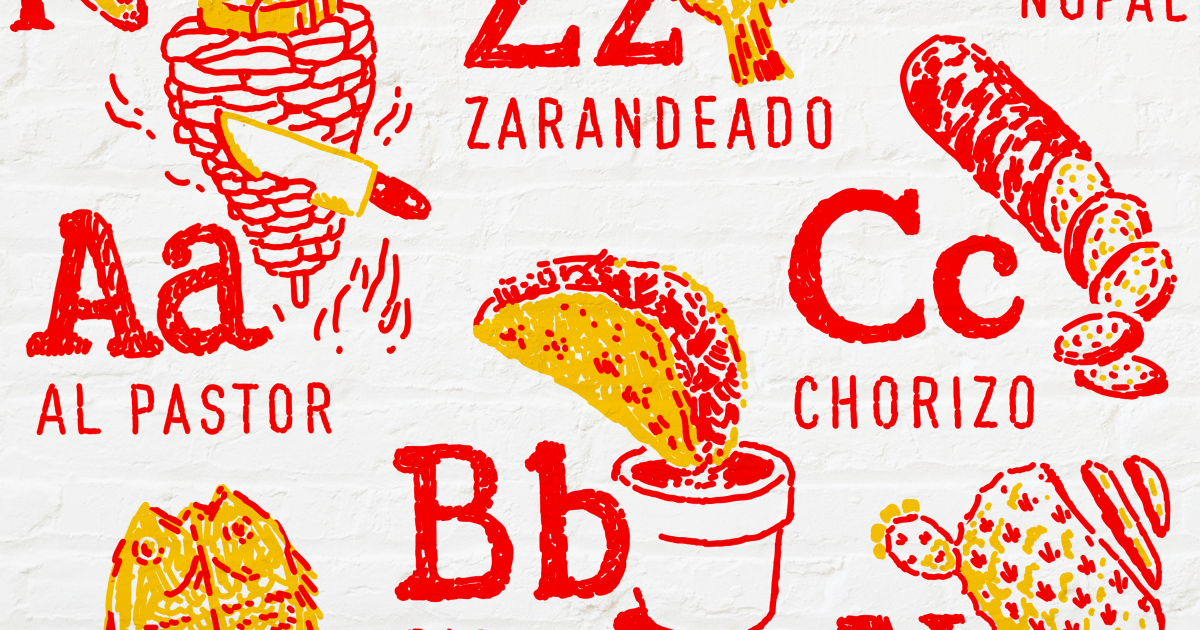When it comes to ordering tacos in Los Angeles, it's helpful to have a few Spanish terms and phrases handy. Keep this glossary handy during your taco runs, and you'll soon be ordering like a pro.

Marinated: Term used to refer to pastor in Tijuana. Meat, usually pork, marinated in a red adobo sauce; roasted on a trompo or sometimes cooked on a griddle or barbecue.
Wire: A plate of mixed meats sautéed on a griddle with chopped bacon, cheese, bell peppers and onions, served in a pile covered with tortillas to form multiple tacos.
On charcoal: On mesquite or charcoal.
Pastor: Pork shoulder extravagantly marinated with guajillo and achiote chiles and other spices, cut into long slices and stacked on a vertical rotisserie called a trompo.

Get to know Los Angeles through the tacos that bring it to life. From restaurants to trucks, carts and more, here are 101 of the best in town.
Steamed: Translated as “steamed tacos,” this type of taco is steamed until it is soft inside and out. The filling can be a mixture of shredded meat and smooth mashed potatoes.
Barbecue: Slow-cooked and spiced meat, such as whole beef, ox head, goat or sheep, traditionally roasted in maguey leaves in a hole in the ground.
Apology: Birria, which is usually cooked over low heat in a clay pot, can be made from goat, beef or lamb. The meat is prepared with a marinade made from different types of chiles (arbol, pasilla, ancho) and spices such as cumin, cloves and sesame seeds, as well as tomato, onion and garlic.
Maw: Pork stomach, also commonly known as pig maw. Like other organ meats, the texture softens and becomes more tender after cooking.
Head: Meat derived from the head of beef, whether roasted, steamed or stewed.
Cache: Veal cheek meat.
Shrimp: Shrimp.
Carnitas: Pork chunks or pieces, literally “small meat,” usually from the shoulder or pork shoulder, but sometimes with belly or other cuts, braised or simmered in lard, preferably in a large copper pot. If you like the meat in your carnitas to be just meaty chunks, order them as “maciza.”
Saucepan: A large, heavy-bottomed pot, often made of copper, traditionally used for slow-cooking carnitas.
Roasted onions: Grilled onions, served whole with green stems or just bulbs, sometimes available together with sauces and lemons for garnish.
Billy goat: Goat.
Corycera:A steel pan with a raised center where various cuts of meat are cooked in their own juices.
Sausage: Finely ground pork sausage heavily seasoned with vinegar and usually red chili peppers. It can also be made with beef.
Choripapa: Chorizo with potatoes.
Pork rind: Generally deep–fried pork belly or pork rinds.
Chop: Pork chop, usually cut into thin slices in a taco shape.
Cochinita pibil: A slow-roasted pork dish from the Yucatán Peninsula that involves marinating the meat of a suckling pig in achiote and citrus juice. The meat is then wrapped in a banana leaf before roasting.
Griddle: A flat cooking appliance used primarily for making fresh tortillas.
Consommé/bouillon: A broth. In Spanish it is called consommé; in English the latter term is used.
With everything: ““With everything”, or “Everything in it”.
Rib: Rib, refers to rib meat, whether beef or pork.
Leather: Cueritos are made from pig skin and are preserved in vinegar, which gives them a salty taste. The short, translucent curls get their name from the Spanish word “cuero.”
Stews: It is a broad term, but it generally refers to stews and casseroles.
Fungus: Mushrooms, also called champignons.
Huitlacoche: A darkened fungus that grows on corn; it has an earthy flavor, often compared to black truffles.
Lemon/lemons: Limes, ideally Jamaican limes or Mexican limes. Green Mexican limes are great for adding a final touch of acidity as a final garnish to a taco. Avoid yellow limes, although many taco shops serve them as a substitute, as they are cheaper and more reliable than imported limes.
Crush: Shredded beef or pork, usually dried and rehydrated by cooking or braising.
Young guy: Like a quesadilla, but with two tortillas instead of one forming a kind of sandwich, filled with meat such as asada, carnitas or al pastor (or beans) plus cheese, and grilled on a griddle.
Prickly pear: Cactus, usually of the Opuntia variety. Nopal is the green part of the cactus, not to be confused with the prickly pear or “tuna.” It can be used in salads, soups, and tacos and when cooked has a flavor similar to green beans with a slightly slimy texture, like okra.
Potatoes: Potatoes.
To go: Go
Fish: Fish.
Iron: A large, flat “cooking plate” for sautéing meats and vegetables or heating tortillas, often taking the form of a flat grill.
Advantage: Or “buen provecho,” a colloquialism from central Mexico that means “bon appétit” or “enjoy your meal.”
Taco stand/booth: Also known as a taco stand or taco table, “puesto” is the Spanish term used for any temporary stand. Sometimes a taco stand is extended into a stand.
QuesabirtoI am tacos: Tacos filled with birria and melted Oaxacan cheese. The tortilla is often dipped in birria juice before frying. Birria broth is often served on the side.
Quesadilla: In the United States, a taco folded in half heated directly on a grill with any cheese, usually in a flour tortilla. In central and southern Mexico, a blue corn tortilla filled with any stew, with or without Cheese. Again, a quesadilla in Mexico can do without cheese.
Quesataco/taco cheese: The cheese is melted with the tortilla on a griddle before adding the filling.
Beef: Steak.
Brains: Cow brain.
Cash only: Cash only.
Suadero: A special cut of fatty beef taken from the middle of the cow or pig, between the lower flank and the sirloin. The meat can be tough to chew, so it is often candied or fried and cut into small pieces.
What happened: It translates as “assorted” and refers to a mix of different cuts of meat in a single taco.
Arab tacos: “Arab” tacos. Middle Eastern immigrants brought the tradition of shawarma to Mexico just after World War I. Lamb was replaced by pork, served in tacos with pan pitas, thick flour tortillas similar to flatbread; chipotle sauce; and milk-based jocoque sauce, a nod to labneh.
Basket tacos: Translates to “basket tacos.” The tortillas are often filled with various stews. The tacos are then covered in oil or melted butter and placed in a basket covered with cloth, allowing the tacos to steam until ready to serve. See al vapor.
Golden tacos: Stuffed tacos that are fried in oil, either deep or shallow; rolled up, they are also known as taquitos and flautas.
Taco shop:An establishment that makes and serves tacos; “taqueria” is a commonly used term in English.
Taco holder/taco girl:Person who presides over the grill and cuts meats and other fillings for tacos.
TortillasTortillas, which are also made from flour in northern Mexico, are mainly prepared with corn dough. Corn is native to Mexico.
Journey: This is not tripe, but the upper part of a farm animal's small intestine, which are thin tubes that are cleaned, boiled and grilled. The meat may taste strong and a little rubbery, but it is delicious when pan-seared.
Trumpet: A vertical rotisserie used to roast skewered meat in layers on a spit by slowly rotating it over open fire, embers, or a propane gas flame. A trompo, literally meaning “spinning top,” is used to prepare al pastor, adobada, and tacos Árabes.
One more: One more, or “One more, please!”
Vampire: An open taco made with corn tortillas that are grilled over an open flame or on a comal until crispy and oozing with melted cheese.
Shaken: A Nayarit method of preparing fish that is cut from head to tail and butterfly cut before roasting over embers or in a wood oven.













